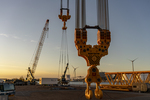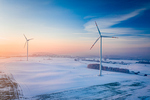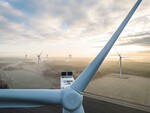04/12/2008
Global wind power capacity up 27 percent from 2007 and tops 100,000 megawatts by April 2008
Global wind power capacity reached 94,100 megawatts by the end of 2007, up 27 percent from the previous year, and then topped 100,000 megawatts by April 2008. The roughly 20,000 megawatts installed in 2007 was 31 percent above the 2006 record for capacity additions. New wind installations were second only to natural gas in the United States as an additional source of power capacity and were the leading source of new capacity in the European Union (EU).
The United States led the world in new installations for the third year in a row with a record-shattering 5,244 megawatts of wind capacity added, increasing cumulative installed capacity by 45 percent. (See Figure 3.) Wind power represented 30 percent of new U.S. capacity additions last year, compared with 1 percent of the total just five years earlier. The nation's wind capacity now totals 16,818 megawatts, second only to Germany, and is enough to power 4.5 million U.S. homes. The surge in 2007 was driven by the federal production tax credit and by renewable energy mandates in 25 states and the District of Columbia. The federal credit is due to expire at the end of 2008, though an extension is widely expected. Texas is the nation's top wind power generator, with 30 percent of total U.S. wind production last year, but six states now each have more than 1,000 megawatts of installed capacity.
Wind capacity in the European Union rose 18 percent in 2007, with new records in several countries. Wind power accounted for about 40 percent of new power installations across Europe. Additions of 8,554 megawatts-an increase of 12 percent over 2006 installations-brought the EU's total to 56,535 megawatts. Total wind capacity installed in Europe by the end of 2007 was enough to meet nearly 4 percent of the region's electricity demand in an average wind year and will avoid about 90 million tons of carbon dioxide emissions annually. For the first time in several years, Europe's wind market dropped below half of the global total as the EU accounted for only 43 percent of new additions worldwide; but Europe still has 60 percent of total global capacity.
Germany remains the world leader in wind power capacity, with a total of 22,247 megawatts, almost 24 percent of the global total. However, Germany's wind market experienced a significant slowdown in 2007. Rising turbine prices in conjunction with falling payments to wind-generated electricity have temporarily made the German market less attractive to developers than the U.S. and British markets are; Germany has also experienced an increasing scarcity of good onshore sites. Only 1,667 megawatts of new capacity were installed in 2007, 25 percent less than added during the previous year. Despite this, the share of electricity that Germany obtained from renewable sources-half of which comes from wind power-continues its rapid rise. Wind power generated the equivalent of 7.2 percent of Germany's electricity consumption in 2007. Windy northern Schleswig-Holstein now aims for the wind to generate all of that state's power by 2020, up from 30 percent today.
Spain led Europe in new installations in 2007, now ranking third worldwide in total wind capacity. An estimated 3,522 megawatts were added last year, bringing the nation's total to 15,145 megawatts, enough to meet 10 percent of Spain's electricity needs.
Other countries in Europe that experienced significant growth in 2007 include France (888 megawatts added), Italy (603), Portugal (434), and the United Kingdom (427), and each of these countries now has total capacity of well over 2,000 megawatts. The United Kingdom and Portugal, however, both experienced slower growth than in 2006. Although Europe (mostly Germany and Spain) and the United States now account for 78 percent of the world's installed wind power capacity, more than 70 nations-from Australia to Zimbabwe-now tap the wind to produce electricity.
The biggest surprise is China, which was barely in the wind business three years ago but which in 2007 trailed only the United States and Spain in wind installations and was fifth in total installed capacity. An estimated 3,449 megawatts of wind turbines were added in 2007, bringing China's provisional total to 6,050 megawatts and already exceeding the government's target for 2010. (An estimated one fourth of this capacity is still not connected to the grid, however, due to planning problems.) Another 4,000 megawatts are expected to be added in 2008 and, based on current growth rates, the Chinese Renewable Energy Industry Association predicts that China's wind capacity could reach 50,000 megawatts by 2015.
Elsewhere in Asia, India added 1,730 megawatts of new capacity and continues to rank fourth overall for total installations, with an estimated 8,000 megawatts. Other regions and countries experiencing significant growth include Canada (added 386 megawatts), New Zealand (151), Latin America, where Brazil added 161 megawatts and Chile installed about 18 megawatts, and northern Africa, where Egypt added 80 megawatts.
These dramatic increases in capacity took place against a backdrop of serious turbine shortages. Wind turbines require some 8,000 components, and suppliers of many of these parts need years to ramp up production. Parts shortages have affected the United States in particular, where numerous projects have been put on hold. As a result, several European companies that had the funds and foresight to lock in orders of new machines have taken this opportunity to buy up smaller companies and utilities to gain a foothold in the United States, where wide open spaces promise an enormous future market.
Manufacturers are now positioning themselves to increase production of gearboxes, rotors, and other components, and it is expected that this will eliminate the turbine shortage by sometime in 2009. For the short term, however, the turbine shortage could dictate how quickly the industry will grow.
These growing pains have affected the economics of wind power. Over the past 15 years, the costs of wind-generated electricity have dropped by 50 percent, while efficiency, reliability, and power rating have all experienced significant improvements. But costs have increased in recent years due to the turbine shortage, rising material costs, and increased manufacturing profitability. (In the United States, costs have also risen thanks to the falling value of the dollar relative to the euro.) Despite the higher costs, wind power remains competitive with new natural gas plants, and all conventional plants have seen similar construction cost increases. Wind power will become increasingly competitive with coal as more countries put a price on carbon.
The global wind market was estimated to be worth about $36 billion in 2007, accounting for nearly half of all investments in new renewable power and heating capacity last year. As many as 200,000 people around the world are currently employed by the wind industry. These numbers will only rise in coming years.
The EU is now committed to generating 20 percent of its primary energy with renewables by 2020, which means that these sources will need to provide about 35 percent of the region's electricity in 12 years, up from 15 percent in 2007. Wind power is expected to account for most of that increase. And the potential for the United States, China, and many other countries is enormous.
The wind industry has consistently blown by past projections-BTM Consult ApS, for example, forecast in 2002 that global capacity would reach 83,000 megawatts by the end of 2007, far short of the 94,100 megawatts that it actually did achieve-and it could continue to do so for years to come.
The United States led the world in new installations for the third year in a row with a record-shattering 5,244 megawatts of wind capacity added, increasing cumulative installed capacity by 45 percent. (See Figure 3.) Wind power represented 30 percent of new U.S. capacity additions last year, compared with 1 percent of the total just five years earlier. The nation's wind capacity now totals 16,818 megawatts, second only to Germany, and is enough to power 4.5 million U.S. homes. The surge in 2007 was driven by the federal production tax credit and by renewable energy mandates in 25 states and the District of Columbia. The federal credit is due to expire at the end of 2008, though an extension is widely expected. Texas is the nation's top wind power generator, with 30 percent of total U.S. wind production last year, but six states now each have more than 1,000 megawatts of installed capacity.
Wind capacity in the European Union rose 18 percent in 2007, with new records in several countries. Wind power accounted for about 40 percent of new power installations across Europe. Additions of 8,554 megawatts-an increase of 12 percent over 2006 installations-brought the EU's total to 56,535 megawatts. Total wind capacity installed in Europe by the end of 2007 was enough to meet nearly 4 percent of the region's electricity demand in an average wind year and will avoid about 90 million tons of carbon dioxide emissions annually. For the first time in several years, Europe's wind market dropped below half of the global total as the EU accounted for only 43 percent of new additions worldwide; but Europe still has 60 percent of total global capacity.
Germany remains the world leader in wind power capacity, with a total of 22,247 megawatts, almost 24 percent of the global total. However, Germany's wind market experienced a significant slowdown in 2007. Rising turbine prices in conjunction with falling payments to wind-generated electricity have temporarily made the German market less attractive to developers than the U.S. and British markets are; Germany has also experienced an increasing scarcity of good onshore sites. Only 1,667 megawatts of new capacity were installed in 2007, 25 percent less than added during the previous year. Despite this, the share of electricity that Germany obtained from renewable sources-half of which comes from wind power-continues its rapid rise. Wind power generated the equivalent of 7.2 percent of Germany's electricity consumption in 2007. Windy northern Schleswig-Holstein now aims for the wind to generate all of that state's power by 2020, up from 30 percent today.
Spain led Europe in new installations in 2007, now ranking third worldwide in total wind capacity. An estimated 3,522 megawatts were added last year, bringing the nation's total to 15,145 megawatts, enough to meet 10 percent of Spain's electricity needs.
Other countries in Europe that experienced significant growth in 2007 include France (888 megawatts added), Italy (603), Portugal (434), and the United Kingdom (427), and each of these countries now has total capacity of well over 2,000 megawatts. The United Kingdom and Portugal, however, both experienced slower growth than in 2006. Although Europe (mostly Germany and Spain) and the United States now account for 78 percent of the world's installed wind power capacity, more than 70 nations-from Australia to Zimbabwe-now tap the wind to produce electricity.
The biggest surprise is China, which was barely in the wind business three years ago but which in 2007 trailed only the United States and Spain in wind installations and was fifth in total installed capacity. An estimated 3,449 megawatts of wind turbines were added in 2007, bringing China's provisional total to 6,050 megawatts and already exceeding the government's target for 2010. (An estimated one fourth of this capacity is still not connected to the grid, however, due to planning problems.) Another 4,000 megawatts are expected to be added in 2008 and, based on current growth rates, the Chinese Renewable Energy Industry Association predicts that China's wind capacity could reach 50,000 megawatts by 2015.
Elsewhere in Asia, India added 1,730 megawatts of new capacity and continues to rank fourth overall for total installations, with an estimated 8,000 megawatts. Other regions and countries experiencing significant growth include Canada (added 386 megawatts), New Zealand (151), Latin America, where Brazil added 161 megawatts and Chile installed about 18 megawatts, and northern Africa, where Egypt added 80 megawatts.
These dramatic increases in capacity took place against a backdrop of serious turbine shortages. Wind turbines require some 8,000 components, and suppliers of many of these parts need years to ramp up production. Parts shortages have affected the United States in particular, where numerous projects have been put on hold. As a result, several European companies that had the funds and foresight to lock in orders of new machines have taken this opportunity to buy up smaller companies and utilities to gain a foothold in the United States, where wide open spaces promise an enormous future market.
Manufacturers are now positioning themselves to increase production of gearboxes, rotors, and other components, and it is expected that this will eliminate the turbine shortage by sometime in 2009. For the short term, however, the turbine shortage could dictate how quickly the industry will grow.
These growing pains have affected the economics of wind power. Over the past 15 years, the costs of wind-generated electricity have dropped by 50 percent, while efficiency, reliability, and power rating have all experienced significant improvements. But costs have increased in recent years due to the turbine shortage, rising material costs, and increased manufacturing profitability. (In the United States, costs have also risen thanks to the falling value of the dollar relative to the euro.) Despite the higher costs, wind power remains competitive with new natural gas plants, and all conventional plants have seen similar construction cost increases. Wind power will become increasingly competitive with coal as more countries put a price on carbon.
The global wind market was estimated to be worth about $36 billion in 2007, accounting for nearly half of all investments in new renewable power and heating capacity last year. As many as 200,000 people around the world are currently employed by the wind industry. These numbers will only rise in coming years.
The EU is now committed to generating 20 percent of its primary energy with renewables by 2020, which means that these sources will need to provide about 35 percent of the region's electricity in 12 years, up from 15 percent in 2007. Wind power is expected to account for most of that increase. And the potential for the United States, China, and many other countries is enormous.
The wind industry has consistently blown by past projections-BTM Consult ApS, for example, forecast in 2002 that global capacity would reach 83,000 megawatts by the end of 2007, far short of the 94,100 megawatts that it actually did achieve-and it could continue to do so for years to come.
- Source:
- Worldwatch Institute
- Author:
- Edited by Trevor Sievert, Online Editorial Journalist
- Email:
- press@windfair.net
- Link:
- www.windfair.net/...
- Keywords:
- wind energy, wind farm, renewable energy, wind power, wind turbine, rotorblade, offshore, onshore


























